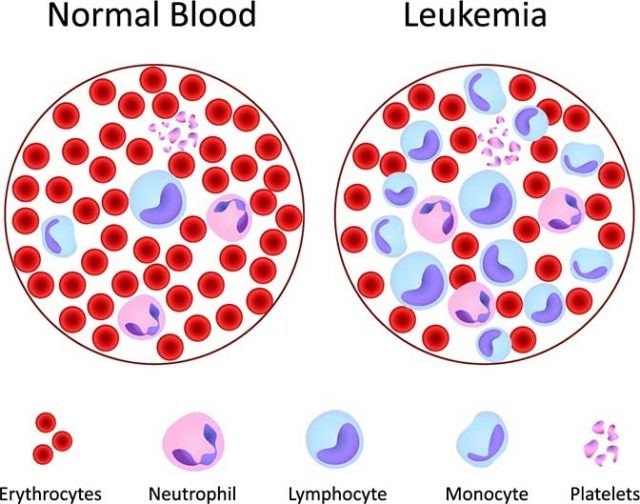
What is blood cancer or leukemia?
Blood cancer or leukemia comes from the proliferation and development of white blood cells in the bone marrow. Leukemia means white blood. Cancer is one of four common cancers in children. In this abnormal bone marrow, excessive blood cells are produced, these cells differ from the original blood cells, causing no other major white blood cells to be produced and prevents the individual to confront with it.
Symptoms of leukemia:
- Anemia
- Whiteness
- weakness
- Fatigue
- Bruising
- Swollen gums
- Fever
- Swollen lymph nodes
- Bone pain and joints
- Severe bleeding
- Blood in the urine or feces
- Purple spots or red and purple spots on the skin
- Reduced appetite
- Swollen Liver or spleen
Causes of leukemia:
- inheritance
- age increasing
- Long-term exposure to pesticides
- Obesity
- Polluted air
- exposure to Radiation
- Use of chemotherapy drugs for breast or ovarian cancer
- Radiotherapy
The organs affected by leukemia include:
- lungs
- digestive system
- Heart
- kidneys
- testicular
Diagnosis of blood cancer:
- Examination and assessment of spleen enlargement, lymph nodes near the thigh, armpit, neck
- blood test
- Bone marrow sampling
- Sampling of spinal fluid
- x-ray imaging, ultrasound and CT scan
Stages of leukemia:
Blood cancer has various stages and early diagnosis in it is very helpful. Treatment for leukemia initiates with determining the extent of the cancer. This is called staging. There are five stages of leukemia:
- stage zero: too many lymphocytes in the blood
- stage I: lymph nodes are swollen
- stage II: lymph nodes, spleen, and liver are swollen
- stage III: anemia has advanced as lymphocytes are crowding out red cells
- stage IV: there are too few platelets in the blood.
Treatment for leukemia:
Treatment for blood cancer depends on the stage of the disease and the following treatments are used to improve the condition.
Chemotherapy:
Blood cancer cells can be removed and depending on the severity the medicines are injected or prescribed.
Radiation therapy:
Using X-rays or other beams, they attack and control blood cancer cells. Due to the progression of the cancer and its severity, radiation may be sent only to one of the organs, or maybe the entire body.
Stem Cell Transplant:
In this method, the treatment of bone marrow damaged by the healthy bone marrow of the person himself or donated bone marrow. This method is called bone marrow transplantation, is usually given before chemotherapy and radiotherapy, during which, as far as possible, damaged cells are removed. Bone grafting is better in young patients.
Biological or immunological treatment:
The immune system helps to cope with cancer cells and eliminate them.
Target Therapists:
Using the drugs, they are used to weaken the stem cells and eliminate them.
Is leukemia fatal!
Blood cancer is one of the most serious and deadly diseases in the world. Although there are many treatments for it today, it can lead to death if it is detected late and the disease progresses.
The likelihood of death in older people is higher than in children and adolescents. Factors such as age, history of blood disorders and chromosomal mutations have a negative effect on blood cancer and increase the risk of death in this disease.
Summary
Leukemia is a type of disorder in blood cells. The symptoms are very delicate and include fatigue, fever, bruising, headaches, extreme bleeding, unintentional weight loss, and infections. There are many ways to treat it, but if it is diagnosed late as the disease progresses, the risk of death increases with the person being treated.












Reviews
Number of pending reviews15083